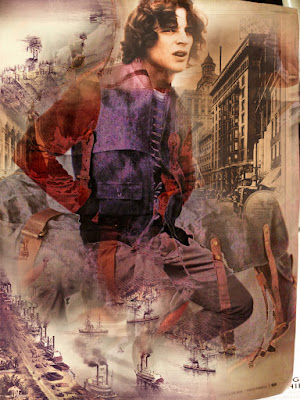 |
I'm a man with a clear destination I'm a man with a broad imagination |
* * * * *
In the last 2 or 3 lines, we learned that the artist Kathryn Dunlevie immersed herself in the solo music of Robbie Robertson – who is best-known as the lead guitarist and primary songwriter of the Band – while working on her Mistick Krewes series of photomontages. (If you missed that post, it's just below this one – just scroll down until you see it.)
Like that previous post, this one starts off with one of the Mistick Krewes images. That particular image is titled “Rag Man.” Its caption consists of three lines from a song called “Somewhere Down the Crazy River,” which was released in 1987 on Robbie Robertson’s eponymous debut solo album.
I’ve strewn other images from the Mistick Krewes series throughout this post.
* * * * *
 |
| “Erato” |
Kathryn explained to me that the title of the Mistick Krewes series was inspired by New Orleans and the social clubs – known as “krewes” – who create a Mardi Gras parade float, host a Mardi Gras ball, or otherwise participate in Mardi Gras celebrations:
In New Orleans in 1857 a newly formed secret society, the Mistick Krewe of Comus, began the tradition of celebrating Mardi Gras with a torch-lit procession of extravagant floats. My Mistick Krewes series is an homage to the rich jumble of that city’s overlapping heritages and the still perceptible aura of its tempestuous history.
 |
| “Bayou Lafourche” |
Since its founding in 1718, New Orleans’ cultural, political and natural landscapes have been continually invaded and eroded, bought and sold, enriched and transformed. A visitor to New Orleans today might pass through districts, buildings and gardens that exhibit the intertwining of centuries of Native American, Spanish, French, African and American influences. City streets are named for Greek muses, native tribes and 18th-century French nobility. Surrounding swamplands are swallowed by encroaching gulf waters. The atmosphere is charged with an air of mystery, a strange sense of desire, and a whiff of something hazily remembered, beckoning from just around the next corner. It is a place where history is revered, and where it can sometimes be “mistickally” re-experienced.
 |
| “Tchoupitoulas” |
In these works I am combining my photographs with imagery from popular as well as archival sources. Adding layer upon layer, revisiting each composition again and again, I am working toward scenarios that compel even as they may mislead. Interweaving elements from nature, history and contemporary life conjures up landscapes populated with plants, wildlife, and otherworldly beings, evoking lost times and the Mardi Gras traditions that celebrate them.
 |
| “Terpischore” |
* * * * *
Robbie Robertson and the other musicians who would eventually become the Band got their start in 1958 playing behind Ronnie Hawkins, a rockabilly singer who was a native of Arkansas. Later they backed up Bob Dylan.
Despite the fact that all the Band’s members save one were Canadian, their music has always sounded more Southern than anything else.
 |
| “Calliope” |
One critic described their first album, Music from Big Pink, as “country soul.” Others noted elements of folk, rock, jazz, and R&B.
The Band’s rootsy, eclectic style is a perfect fit for the cultural melting pot that is New Orleans. Not surprisingly, Robertson – like Kathryn Dunlevie – feels a deep affinity for the Crescent City.
“New Orleans has always felt like a second home to me musically and spiritually,” he once said.
 |
| “Calcasieu” |
A few years after completing work on the Robbie Robertson album, Robertson traveled to New Orleans to collaborate with Aaron and Ivan Neville on the 1991 album, Storyville – which got its title from the New Orleans neighborhood that was once the city’s red-light district.
Many of Storyville’s brothels employed musicians – Joe “King” Oliver, Jelly Roll Morton, and Louis Armstrong were among them – to entertain their patrons.
 |
| “Pontalba” |
* * * * *
Click here to listen to “Testimony,” the final track on the Robbie Robertson album.
Testimony is also the title of Robertson’s 2016 autobiography, which the New York Times described as “[c]onfident and well oiled, [with] the mythic sweep of an early Terrence Malick movie.” (If you’re familiar with Terrence Malick’s first two movies, Badlands and Days of Heaven, you know that’s high praise indeed.)
Click below to buy Testimony from Amazon:



No comments:
Post a Comment